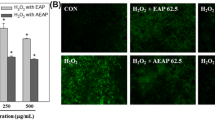Abstract
Two flavonols quercetin and myricetin were assessed for their in vitro activities to attenuate the acrylamide-induced cytotoxicity and barrier loss in rat intestinal epithelial (IEC-6) cells and to identify whether heat treatment of the flavonols might cause activity changes. The results showed that the flavonols could alleviate the acrylamide-caused cell injury, resulting in higher cell viability, lower lactate dehydrogenase release, and less formation of reactive oxygen species. Meanwhile, the flavonols could antagonize the acrylamide-induced barrier dysfunction via decreasing the paracellular permeability, increasing the transepithelial resistance of cell monolayer, and enhancing the expression of three tight junction proteins namely occludin, claudin-1, and zonula occludens-1. The flavonols also could down-regulate the expression of JNK/Src proteins and thus cause lower relative protein ratios of p-JNK/JNK and p-Src/Src, resulting in a suppressed JNK/Src activation. Totally, quercetin was more potent than myricetin to exert these assessed activities, while the heated flavonols obtained lower activity than the unheated ones. It is thus concluded that the flavonols had beneficial activities towards the intestinal epithelial cells with acrylamide exposure by alleviating the acrylamide-induced cytotoxicity and barrier disruption, while heat treatment of the flavonols was unfavorable because it led to a reduced flavonol activity to the cells.






Similar content being viewed by others
Data Availability
Data sharing not applicable to this article as no datasets were generated or analysed during the current study.
References
Sánchez-Otero MG, Méndez-Santiago CN, Luna-Vázquez F, Soto-Rodríguez I, García HS, Serrano-Niño JC (2017) Assessment of the dietary intake of acrylamide by young adults in Mexico. J Food Nutr Res 5:894–899
Shi J, Zhao XH (2019) Chemical features of the oligochitosan-glycated caseinate digest and its enhanced protection on barrier function of the acrylamide-injured IEC-6 cells. Food Chem 290:246–254
Hong YL, Nan B, Wu X, Yan HY, Yuan Y (2019) Allicin alleviates acrylamide-induced oxidative stress in BRL-3A cells. Life Sci 231:e116550
Uthra C, Shrivastava S, Jaswal A, Sinha N, Reshi MS, Shukla S (2017) Therapeutic potential of quercetin against acrylamide induced toxicity in rats. Biomed Pharmacother 86:705–714
Fan J, Zhao XH, Li TJ (2021) Heat treatment of galangin and kaempferol inhibits their benefits to improve barrier function in rat intestinal epithelial cells. J Nutri Biochem 87:e108517
Fan J, Li BR, Zhang Q, Zhao XH, Wang L (2021) Pretreatment of IEC-6 cells with quercetin and myricetin resists the indomethacin-induced barrier dysfunction via attenuating the calcium-mediated JNK/Src activation. Food Chem Toxicol 147:e111896
Chang CJ, Lin JF, Chang HH, Lee GA, Hung CF (2013) Lutein protects against methotrexate-induced and reactive oxygen species-mediated apoptotic cell injury of IEC-6 cells. PLoS ONE 8:e72553
Chen ZD, Wu CY, Liu YT, Li HN, Zhu YY, Huang CL, Lin HB, Qiao Q, Huang MM, Zhu Q, Wang L (2020) ELABELA attenuates deoxycorticosterone acetate/salt-induced hypertension and renal injury by inhibition of NADPH oxidase/ROS/NLRP3 inflammasome pathway. Cell Death Dis 11:e698
**ao WD, Chen W, Sun LH, Wang WS, Zhou SW, Yang H (2011) The protective effect of enteric glial cells on intestinal epithelial barrier function is enhanced by inhibiting inducible nitric oxide synthase activity under lipopolysaccharide stimulation. Mol Cell Neuro Sci 46:527–534
Velalopoulou A, Tyagi S, Pietrofesa R, Arguiri E, Christofidou-Solomidou M (2016) The flaxseed-derived lignan phenolic secoisolariciresinol diglucoside (SDG) protects non-malignant lung cells from radiation damage. Int J Mol Sci 17:e7
Martiniakova M, Blahova J, Kovacova V, Babikova M, Mondockova V, Kalafova A, Capcarova M, Omelka R (2021) Bee bread can alleviate lipid abnormalities and impaired bone morphology in obese Zucker diabetic rats. Molecules 26:e2616
Murakami M, Yamaguchi T, Takamura H, Matoba T (2004) Effects of thermal treatment on radical-scavenging activity of single and mixed polyphenolic compounds. J Food Sci 69:7–10
Wang B, Wang J, Zhao XH (2017) In vitro activities of the four structurally similar flavonols weakened by the prior thermal and oxidative treatments to a human colorectal cancer line. J Food Biochem 41:e12310
Yousef MI, El-Demerdash FM (2006) Acrylamide-induced oxidative stress and biochemical perturbations in rats. Toxicology 219:133–141
Chen W, Shen Y, Sun HM, Zheng XD (2014) Hispidin derived from Phellinus linteus affords protection against acrylamide-induced oxidative stress in Caco-2 cells. Chem-Biol Interact 219:83–89
Hirotani Y, Ikeda K, Kato R, Myotoku M, Umeda T, Ijiri Y, Tanaka K (2008) Protective effects of lactoferrin against intestinal mucosal damage induced by lipopolysaccharide in human intestinal Caco-2 cells. Yakugaku Zasshi 128:1363–1368
Guzman JR, Conlin VS, Jobin C (2013) Diet, microbiome, and the intestinal epithelium: An essential triumvirate? BioMed Res Int 2013: e425146
** MY, Wang YZ, Wang YX, Li YP, Wang GL, Liu XZ, Xue YH, Liu ZG, Li C (2020) Protective effects oncorneal endothelium during intracameral irrigation using N-(2)-l-alanyl-l-glutamine. Front Pharmacol 11:e369
Han R, Wang L, Zhao ZG, You LJ, Pedisić S, Kulikouskaya V, Lin ZQ (2020) Polysaccharide from Gracilaria lemaneiformis prevents colitis in Balb/c mice via enhancing intestinal barrier function and attenuating intestinal inflammation. Food Hydrocolloids 109:e106048
Sharma S, Tripathi P, Sharma J, Dixit A (2020) Flavonoids modulate tight junction barrier functions in hyperglycemic human intestinal Caco-2 cells. Nutrition 78:e110792
Samak G, Chaudhry KK, Gangwar R, Narayanan D, Jaggar JH, Rao R (2015) Calcium/Ask1/MKK7/JNK2/c-Src signalling cascade mediates disruption of intestinal epithelial tight junctions by dextran sulfate sodium. Biochem J 465:503–515
Tsuchiya H (2010) Structure-dependent membrane interaction of flavonoids associated with their bioactivity. Food Chem 120:1089–1096
Acknowledgements
This study was funded by the Scientific Research Foundation of Guangdong University of Petrochemical Technology (Project No. 2020rc026). The authors thank the anonymous reviewers for their valuable advice.
Author information
Authors and Affiliations
Corresponding authors
Ethics declarations
Conflict of Interest
The authors declare that there is no conflict of interest.
Additional information
Publisher’s Note
Springer Nature remains neutral with regard to jurisdictional claims in published maps and institutional affiliations.
Rights and permissions
About this article
Cite this article
Fan, J., Zhang, Q., Zhao, XH. et al. The Impact of Heat Treatment of Quercetin and Myricetin on their Activities to Alleviate the Acrylamide-Induced Cytotoxicity and Barrier Loss in IEC-6 Cells. Plant Foods Hum Nutr 77, 436–442 (2022). https://doi.org/10.1007/s11130-022-00994-z
Accepted:
Published:
Issue Date:
DOI: https://doi.org/10.1007/s11130-022-00994-z




